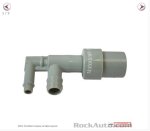A little back story before getting to issue. About 3,000 miles ago I had to have motor overhauled, cylinders honed, new rings, new rod and main bearings, due to low compression on number 3 cylinder and truck running like crap. After reinstalling motor still had same issue with how it was running, extremely rough idle, missing in low rpms, but after about 100 miles it started to smooth out some. Now it is back to rough idle and missing at lower rpm but runs smooth once above 25-30 MPH. Now to the current issue, while pulling codes yesterday we got a cylinder imbalance error so i was thinking possible low compression again, maybe rings didn't seat so i pulled oil filler cap to see if I had any blowby and I didn't, but engine smoothed out a little bit. I pulled hose from valve cover to throttle body off of valve cover (picture 1) and you could hear air "sucking", I have vacuum sucking back into the valve cover. I also noticed something that sounded like wire loom may be vibrating against something, so I got to moving wire loom around and brushed against the hose from the PCV valve to intake manifold and the sound I heard was the ball in the PCV valve. I pulled the valve and it does move when shaking it but motor runs smoother with the valve not in the rubber grommet (Picture 3). According to all the valves I have checked at parts stores, that is not the correct valve as they show one with connections for vacuum lines and this one does not have them (picture 2). I have no stray vacuum lines anywhere in the engine compartment so there is no way I can even start to check with moving lines. The codes that were pulled are 116, 327 (egr is unhooked at this time waiting in new style connector), 411 and 538. Is there any chance that I may have a PCM issue with the age of the truck and what would cause vacuum at the valve cover? I did an edit and posted a picture, number 4, of what the parts stores show as the correct PCV valve.
Attachments
Last edited:
















